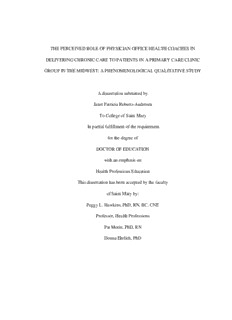
Roberts-Anderson, Janet Patricia. The Perceived Role of Physician Office Health Coaches In ... PDF
Preview Roberts-Anderson, Janet Patricia. The Perceived Role of Physician Office Health Coaches In ...
THE PERCEIVED ROLE OF PHYSICIAN OFFICE HEALTH COACHES IN DELIVERING CHRONIC CARE TO PATIENTS IN A PRIMARY CARE CLINIC GROUP IN THE MIDWEST: A PHENOMENOLOGICAL QUALITATIVE STUDY A dissertation submitted by Janet Patricia Roberts-Andersen To College of Saint Mary In partial fulfillment of the requirement for the degree of DOCTOR OF EDUCATION with an emphasis on Health Professions Education This dissertation has been accepted by the faculty of Saint Mary by: Peggy L. Hawkins, PhD, RN, BC, CNE Professor, Health Professions Pat Morin, PhD, RN Donna Ehrlich, PhD 2 We herby certify that this dissertation, submitted by Janet Roberts-Andersen, conforms to acceptable standards and fully fulfills the dissertation requirements for the degree of Doctor in Education from College of Saint Mary Peggy L. Hawkins, PhD, RN, BC, CNE Committee Chair Pat Morin, PhD, RN Committee member Donna Ehrlich, PhD Committee member 3 Copyright Date 2009 Janet Roberts-Andersen 4 Dedication I wish to express appreciation to the faculty of College of Saint Mary for developing the Health Professions Education Emphasis Program for doctoral students. The guidance and support of my advisor Peggy Hawkins was instrumental in the completion of my doctoral study. This study is dedicated to my parents Lloyd and Mona Roberts and my brother David whose lives were cut short because of a lack of coordinated integrated healthcare. Finally, this work is also dedicated to my husband Timothy and children Emily and Lance who will benefit from a healthcare system that responds to the needs of communities it seeks to serve. 5 THE PERCEIVED ROLE OF PHYSICIAN OFFICE HEALTH COACHES IN DELIVERING CHRONIC CARE TO PATIENTS IN A PRIMARY CARE CLINIC GROUP IN THE MIDWEST: A PHENOMENOLOGICAL QUALITATIVE STUDY Janet Roberts-Andersen, MT (ASCP), MS ABSTRACT Newly hired Physician Office Health Coaches (POHCs) were part of a system delivery redesign to improve patient centered care that utilized disease registries to expose care opportunities, adoption of standardized clinical standards, and use of health care teams to create new relationships with activated, empowered patients. The purpose of this study was to explore the perceived experiences of POHCs as they delivered quality chronic care to patients. Field research was conducted at seven primary care family medicine or internal medicine clinics within a clinic organization and consisted of seven interviews with POHCs. The research question was how do POHCs describe the experience of their role in primary care clinics’ implementation of the Chronic Care Model? To interpret interview transcripts, NVivo software assisted analysis and themes emerged. By using the Transtheorectical Model of behavior change with motivational interviewing, POHCs assisted patients to explore their ambivalence, move toward positive goal setting, and learn skills necessary for self-management. Physician Office Health Coaches identified chronic care delivery opportunities by creating and maintaining a disease registry which in turn nurtured a relationship with patients. They utilized the techniques of motivational interviewing to assist patients in goal setting and 6 tracked patient progress through chart reviews. Acting as an extension of the doctor, being an advocate for patients, and a resource for information were all roles for coaches. The POHCs also challenged old ways of delivery to try new processes using PDSA cycles. 7 Table of Contents page Abstract ............................................................................................................................5 CHAPTER I: INTRODUCTION ....................................................................................12 Purpose of the Study ....................................................................................................12 Context of the Problem ................................................................................................12 Research Questions .....................................................................................................13 Delimitations ................................................................................................................13 Limitations ...................................................................................................................13 Definition of Terms......................................................................................................14 CHAPTER II: REVIEW OF LITERATURE .................................................................18 Historical Context ........................................................................................................18 System Redesign .....................................................................................................22 Workforce Issues and Preparation ..........................................................................24 Theoretical Context ......................................................................................................26 CHAPTER III: METHODOLOGY ................................................................................32 Research Design...........................................................................................................32 Identification of Sample ...............................................................................................35 Ethical Considerations .................................................................................................35 Procedure .....................................................................................................................37 Data Analysis ...............................................................................................................39 CHAPTER IV: RESULTS ..............................................................................................41 Introduction ..................................................................................................................41 Data Analysis ...............................................................................................................43 8 Theme 1: Goal Setting .............................................................................................44 Theme 2: Educator ...................................................................................................47 Theme 3: Relationship with the Patient ....................................................................48 Theme 4: Chart Review ............................................................................................51 Theme 5: Extension of Doctor ..................................................................................53 Theme 6: Advocate for Patient .................................................................................56 Theme 7: Resource Information ...............................................................................57 Theme 8: Change Agent ...........................................................................................59 Theme 9: Challenges.................................................................................................61 Summary of Analysis ...................................................................................................63 CHAPTER V: DISCUSSION AND SUMMARY .......................................................64 Research Questions and Interpretation ......................................................................64 Implications for the Profession ..................................................................................65 Limitations after Conducting the Study .....................................................................65 Future Research .........................................................................................................66 References ....................................................................................................................67 Appendices ...................................................................................................................72 A. Health Coach Job Description..............................................................................72 B. 5 A’s Worksheet ...................................................................................................76 C. PDSA Cycle worksheet ........................................................................................77 D. Conversation Flow worksheet ..............................................................................78 E. Application for Research Approval College of Saint Mary .................................79 F. IRB Approval Form College of Saint Mary .........................................................81 9 G. College of Saint Mary The Rights of Research Participants ...............................82 H. Mercy Medical Center Waiver of Consent Application ......................................83 I. Mercy Medical Center Waiver of Informed Consent Application Receipt ...........86 J. Mercy Medical Center Committee Notification ....................................................87 K. Mercy Medical Center Approval .........................................................................88 L. Certificate of Competition Protecting Human Subjects Research Participants....89 J. Interview and Field Note Worksheet .....................................................................90 10 LIST OF TABLES TABLE page 1. Attributes of Physician Office Health Coaches ..................................................41 2. Tree Nodes as Themes from POHC Interviews ..................................................43
Description: